“Strategizing”, “Journaling”, “Bulleting” – If you’re tired of hearing buzzwords like these from various sites that promote tips for increasing productivity, then we’re right with you!
From Time Tracking to following the Pomodoro Technique – there are multiple ways of managing time, creating schedules, organizing thoughts, and coming up with strategies. While it’s true that to be productive, one needs the right tools – it’s important to find tools that work with you and not against you.
Today, we’re going to look at one of the easiest, yet highly malleable tools of organizing data – the Concept Map! At a glance, concept maps might seem like a randomly growing tree-like flowchart. However, they’re much more than that!
Created in the 1970s by Prof. Joseph D. Novak and his research team, it aimed to help map out the knowledge of students. Since then, concept mapping has found its way into mainstream media.
Today, it is used by technical writers, software engineers, instructional designers, and even students to organize their notes! The key to its versatility lies in the varying levels of difficulty it can represent. Very few tools are capable of adjusting to all levels of understanding.
Don’t believe us? Here’s a concept map explaining photosynthesis:
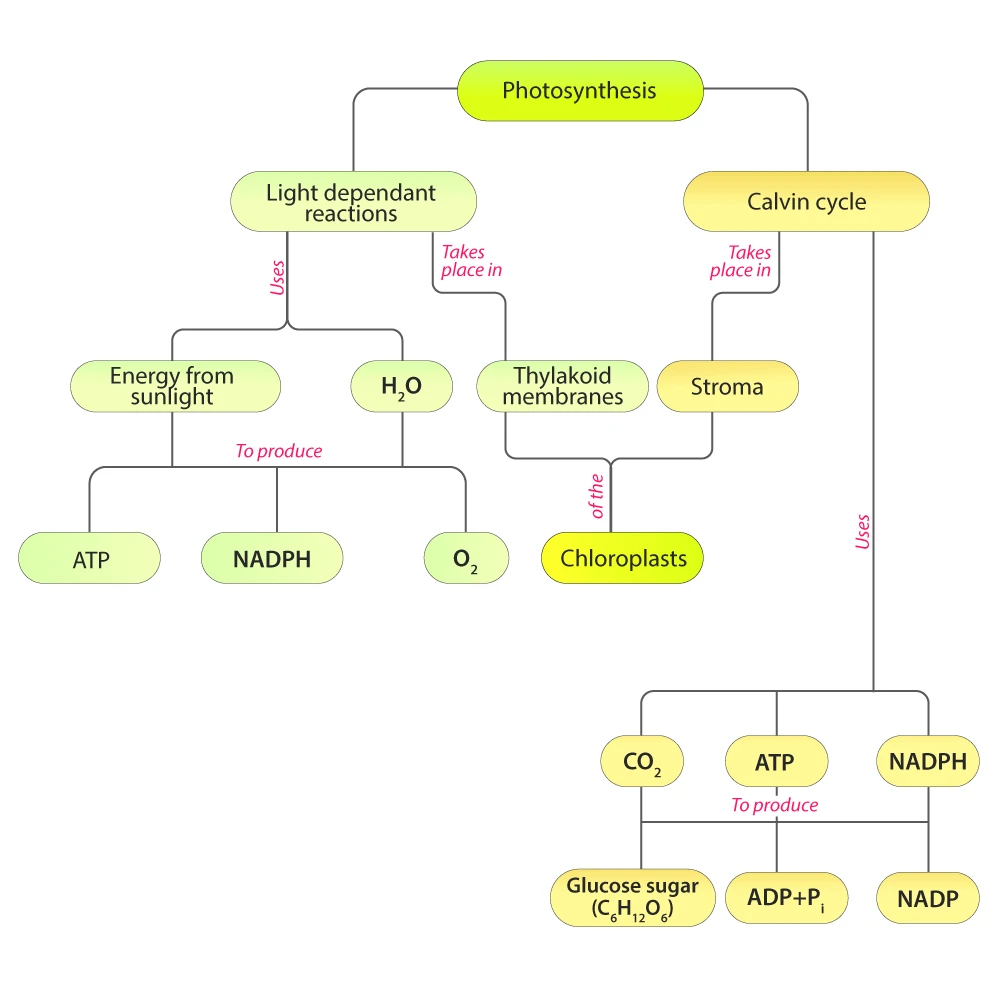
Source: Byju’s
And here’s another concept map explaining photosynthesis:
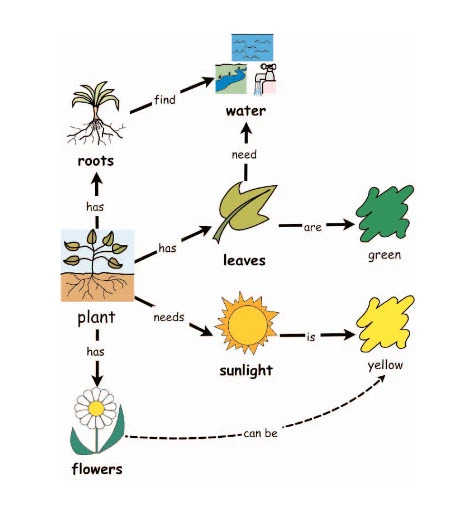
Source: Sentarmeenunanube
Both explain the same concepts, but are targeted towards different user groups! This scalability makes it suitable for use to teach students as well as to design software. In fact, concept maps are commonly used in Unified Modeling Language diagramming to develop methodologies.
So, what exactly are concept maps and how can you benefit from them? Let’s dive into it!
What is Concept Mapping
A concept map offers a visual representation of an idea, by mapping out the connections between various “pieces” of it. Each piece has a linkage between it which defines its relationship. Essentially, it helps one to simplify concepts and view them in a structured manner.
Essentially concept maps depict the connections or hierarchies between various elements. Humans are highly visual creatures. In fact, 65% of us fall under the category of visual learners. Concept maps simply aid in this, by offering visual data that complements our understanding.
They can be drawn on paper, though today many online tools exist for the same. A concept map maker is a template that will allow you to quickly draw concepts by providing auto-linkages and extensions for it.
A Guide To Concept Maps
A Concept Map consists of 4 different elements. These are:
- Concepts – These are contained in the main box and represent the main idea and further branches from it.
- Linkages – These are the lines that connect various concepts and may denote their relationship. Linkages can indicate things like “causes”, “because of”, “adds to”, etc.
- Hierarchy – The main feature of a concept map that makes it easy to understand. You can design a concept map from top to bottom, or radially with the core element at the center.
- Proposition – Once you start branching, you might be able to find new ideas, or propositions by combining multiple concepts. Circle them and write a few sentences for your proposition!
Here’s an example of a top-down concept map:
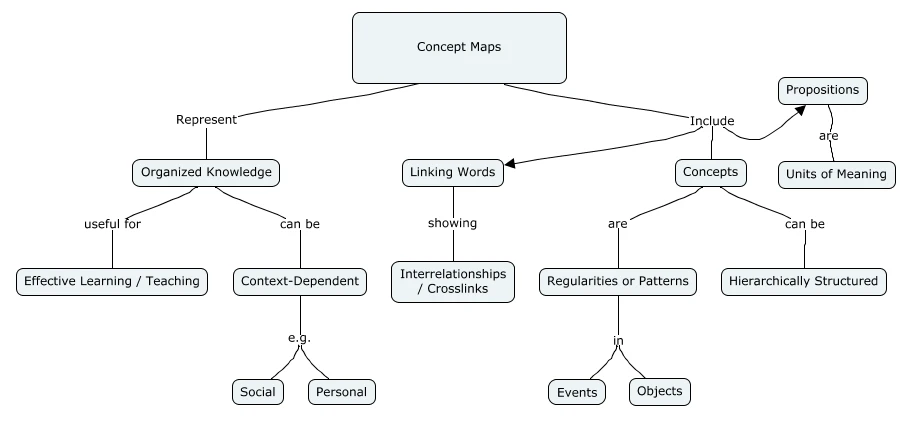
Source: Learning Scientists
You can also add any other elements to your concept maps like nodes, conditions, multiple branches, and more. After all, be the master of your tools!
One of the best features of thinking tools like concept maps and mind maps is that the rules are few and very dependent on you! As long as it is visually coherent and allows one to glean ideas, the concept map has done its job. It’s best to find a concept map maker that allows such freedom and does not restrict the user within a concept-and-linkage structure. But don’t worry, we’ll get to that later.
Usage
Now that you know how to create a concept map, you might be wondering how exactly it can be used. If you’re a part of a marketing or strategizing team or need a concept map maker for students – what you’re most used to looking at is data. The next step would be organization and gleaning insights or explaining these to a group. It is this gap that concept maps can bridge by:
- Help in visual learning
Dealing with multiple components can be tough. While excel sheets and sticky notes can only go so far – concept maps can go further! Besides allowing one to fully visualize only the important assets of a relationship, it can help you see at a glance how each component is affected by the other.
- Usage scenario – Stakeholder Mapping
Here’s an example of how one can better visualize the stakeholders for a local kirana store. The linkages state how the two concepts are connected and help one better visualize how everyone is related.
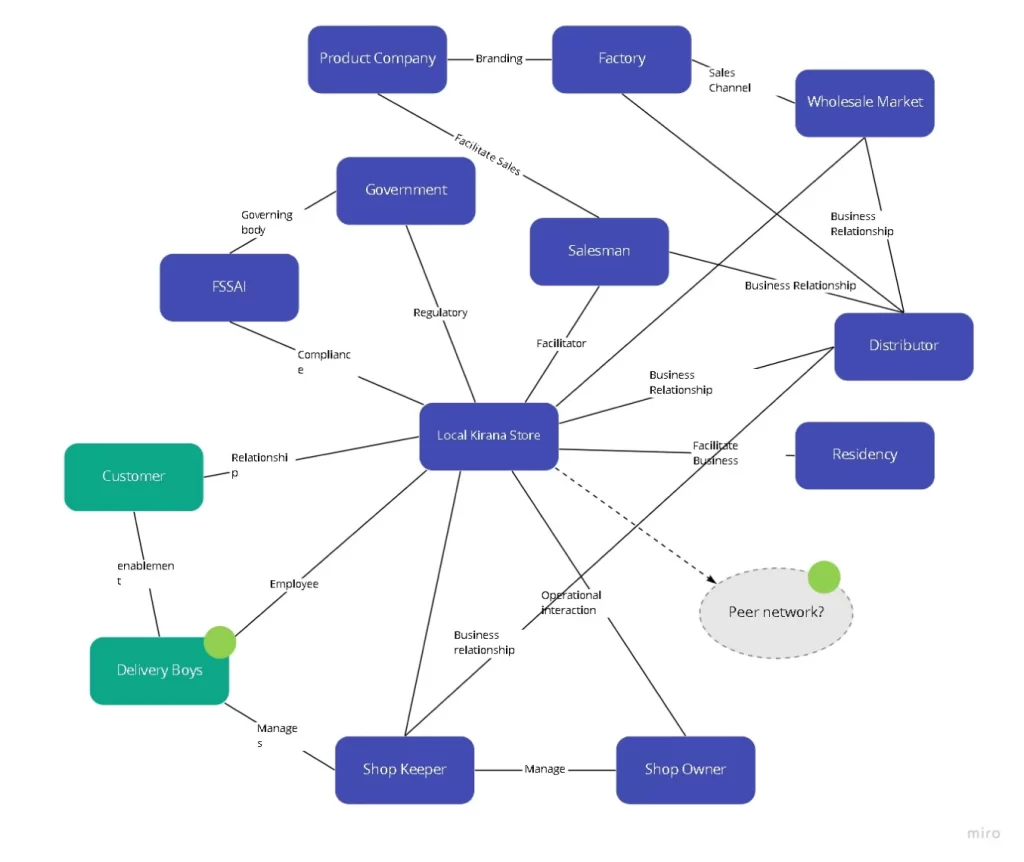
Source: Behance
- Get a better understanding
With a clearer picture on the table, it’s easier to identify potential problems. Potential problems include concepts that are not well-integrated into the system.
- Usage scenario – Understanding relationships
If a component does not have enough connections or has too many – it could be an indicator of a disbalance. You can also start off a concept map with the components and then connect them later. This way, if some component remains an “orphan” – or disconnected – it could lead to a refining of your idea.
- Helpful in strategizing
Identifying such anomalies as above and rectifying them can lead to an effective strategy! Strategies may include adding new components/ concepts, moving around concepts, changing their linkages, and adding conditional linkages.
- Usage scenario – Adding new components
In the example above, a new strategy called “Peer Network” has been added into the midst. This will lead to further refining of the concept map – and who knows, one might come up with a sustainable model that includes a Peer Network!
How a Concept Map Maker can help
Concept maps can be adapted across spheres, and this flexibility allows them to be used across industries to achieve results. The various domains it is used in are:
- Technical writers – to structure reports and knowledge presentation
- Engineers and Software Developers – to understand the various hierarchies via which products are developed, or to organize programs
- Designers – to understand customer journeys, design processes and map ideas
- Educators – to visually explain concepts to students
- Novelists – to create plotlines, manage character information and map ideas
- Marketing Teams – to gauge customer needs and formulate a strategy
Tools for Concept Mapping – Concept Map Maker
While concept maps can be drawn on paper, an online concept map maker makes the task much easier. Free concept map maker tools allow one to quickly add ideas, link them and get an exportable format for sharing across boards. Simple and easy to use, using a concept map maker can be a great way to present your ideas and thoughts to others! Here are some paid and free concept map maker online you can look at:
- Creately – The concept map maker for beginners
Let’s begin the list of concept map makers with a tool from a team that greatly understands the pros and cons of online communication. While Creately’s team also offers online whiteboards, and press kits – we are looking exclusively at their concept map maker.
For full freedom, Creately allows a blank and infinitely scalable canvas for one to work in. As a concept map maker, Creately definitely wins since it has much space for interaction and customization. Moreover, it focuses extensively on collaboration with its features like video calls and comment screens. It’s similar to Zoom, Paint, and Google Docs mashed in, and we love it!
Moreover, you can edit any linkage to add sentences to it, assign colors to various parent nodes, create infinite branches, and add focus questions. Some other cool features are being able to search within this infinite canvas and adding propositions by using canvases or frames. As a concept map maker, Creately pretty much supports every need we discussed earlier.
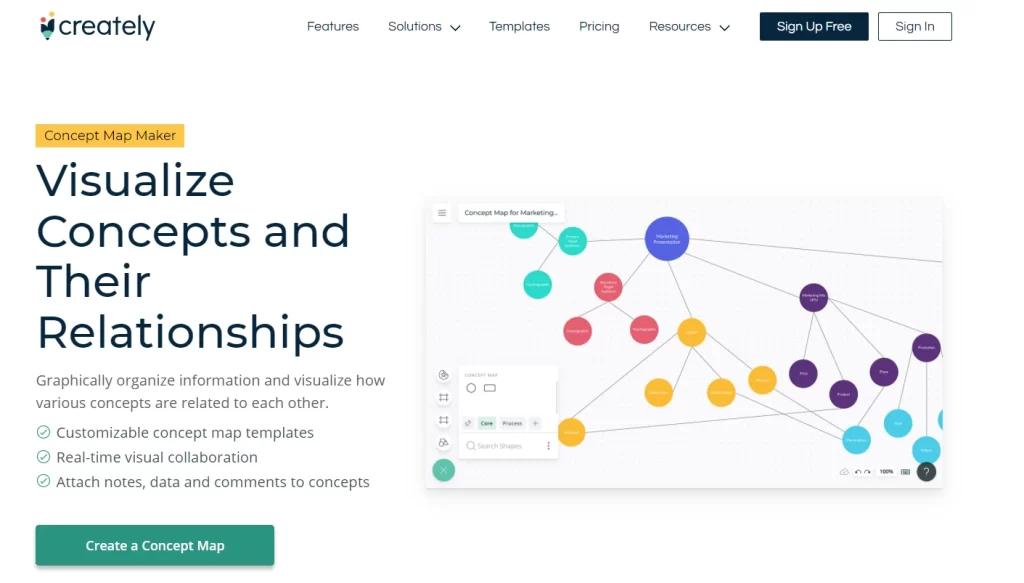
Key Features
- Templates – available so that you can quickly add topics and sub-topics. Creately offers various template styles and breakdowns of different complexity levels.
- Interaction – Creately’s maps are highly interactive. You can easily move around components without affecting linkages.
- Collaboration – Concept maps are often team efforts. This is why Creately offers real-time collaboration where you can see and edit your peer’s works. You can actively monitor their cursors and enjoy features like calling their cursors to you. One can also start a video conference within the concept map page.
- Additions – For visual richness, Creately allows you to add images, link references, documents, videos, and more onto the map! Hence you can create visual maps for presentations.
- Export – Data can be exported as images, PDFs, or printed directly.
Pricing
Free – Only up to 60 elements allowed, with 5 collaborators and 3 documents. Community support is available.
Personal plan at $4 per month – Unlimited documents and components, with 5 collaborators and email support.
Team plan at $4.75 per month – Same features as above with unlimited collaborators and priority support.
Enterprise plan – at custom pricing.
Best Used For
Creately is highly visual. It allows various levels of color-coding, linkage types, and real-time collaboration making it ideal for team use. Being able to add references means you can export any map directly for presentations or use it for personal reference. It is best for large teams as the plan with infinite collaboration comes at just $0.75 more than the personal plan. It is also a great concept map maker for students who can buy it as a class and use it for collaboration.
- LucidChart – A business-level concept map maker
Describing itself broadly as a visual workspace, LucidChart does more than simply allow one to draw a concept map. It essentially allows one to create all types of diagrams be it a mind map or a flowchart. With its various component styles and easy visual language, it is a concept map maker for students, designers, marketers, and teachers alike.
Unlike Creately, which focuses on singular types of components and mainly allows component separation by color-coding, Lucid Chart allows both color and shape separation. It has a huge component library and multiple linkage styles. Each linkage can be conditioned.
They also have various templates for industries like sales, UX, manufacturing, and more. On the whole, Lucid Chart allows one to create concept maps of higher-level complexities using different linkages. You can use it to visualize technical systems and large-scale business processes as well.
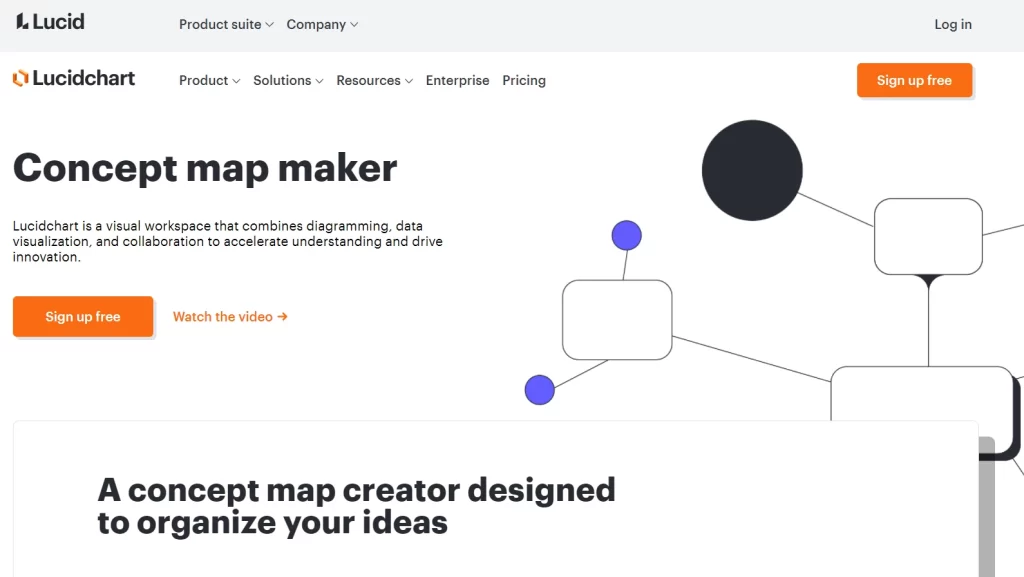
Key Features
- Templates – All types of templates with filled-in dummy data to aid productivity. These templates are divided by style (top-down, radial, spider) and by industries (HR, sales).
- Integrations – Lucid Chart’s position as a concept map maker for mainly business and marketing use means it integrates with tons of other tools! This includes Amazon, Confluence, G Suite, Teams, and more.
- Visual Board – Infinite workspace with various component styles, editable linkages with space for conditions and propositions. Both free-form and orderly concept mapping is possible. Can create components and subcomponents and customize their editing capacities.
- Export – Multiple export options as images, PDFs, and embed as a code.
- Automation – Can generate diagrams from entered data all by itself!
Pricing
Free – 3 documents with access to 100 templates and basic integrations.
Individual plan at $7.95 per month – Unlimited documents with 1000+ templates, and the same features as above.
Teams plan at $9.00 per user per month – Needs a minimum of 3 users, with advanced integrations and admin control panel.
Enterprise plan – at custom pricing
Best Used For
It has the same level of customization as Creately, but is more suited towards businesses than students or educators. Lucid Chart is also exploring its capacities of automation by allowing self-diagram generation and offering users the ability to code and make changes to the concept organizations themselves. On the whole, to fully utilize LucidChart, one would need to go through a considerable learning curve.
- Miro – A great collaborative concept map maker for smaller teams
If you’ve been working collaboratively online for the past year, you must have heard the name, Miro. Miro is an online concept map maker that offers an infinite canvas and numerous shortcut tools to speed up your process. Miro’s best feature is their template map which contains every type of mapping idea. This ranges from Kanban frameworks to timelines, mind-maps, user journeys, and more.
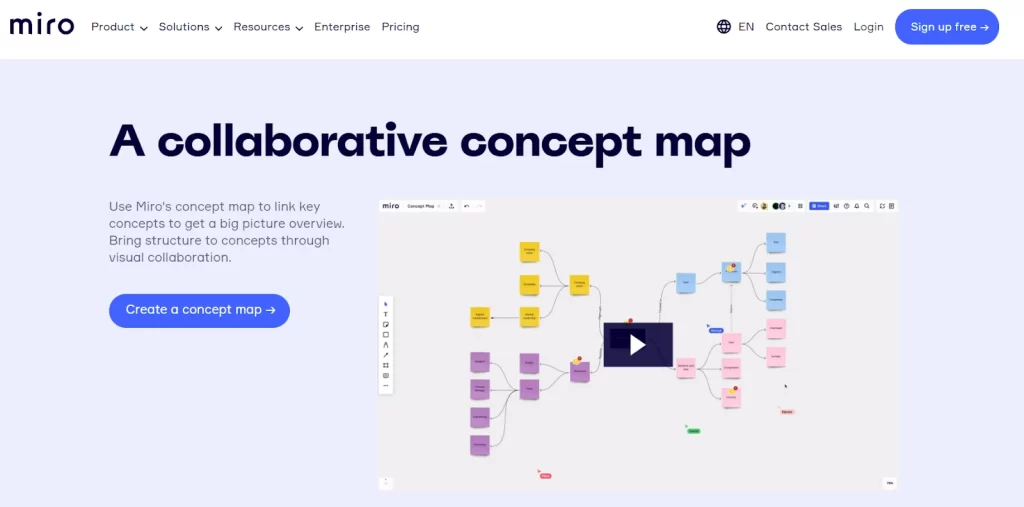
Miro’s template variety has made it a top favorite among designers. It certainly helps that their templates are organized by industry sectors. However, Miro takes the concept of online working a step further and allows various types of tools like voting, on-call conferences, being able to see each other’s cursors, and embedding any type of information on the screen from videos to PDFs and links.
A special feature of Miro that deserves a mention is its ability to create frames that allow direct presentation from its screens in the form of a PPT.
Key Features
- Templates – Apart from their own templates, users can create and upload their own.
- Collaboration – Conference calls, on-screen mouse following, hierarchical sharing of boards among members (allows the creation of private boards), arranging of work by teams.
- Visual Board – Infinite canvas with all tools present on the left. Tools include templates as well as linkages and free-drawing tools.
- Smart Diagramming – Use smart shapes from various existing methodologies like a Data Flow Diagram.
- Export – As JPEGs, PNGs, PDFs, and vectors.
- Integrations – with commonly used online tools like Zoom, Slack, Microsoft Teams, Trello, Zapier.
Pricing
Free – Only 3 boards per team, with unlimited team members allowed.
Teams plan at $8 per month – Unlimited boards and visitors with the ability to private boards.
Business plan $16 per month – Above features along with smart diagramming and conferencing option, and SSO login.
Enterprise plan – at custom pricing.
Best Used For
Both freelancers, students, and teams! Miro’s greatest asset is that it does not limit the number of people working on it, even in the free package. As a concept map maker for students, the free plan is enough for teams as each board is infinite and can hold multiple projects if arranged properly. While it does support unlimited members, the online tool slows down considerably and hence, is best suggested for smaller teams.
- Canva – A concept map maker for presentations
You might be more familiar with Canva as a tool for creating graphics. However, their online design tool is multifaceted and can create some great concept maps as well! Canva’s concept map maker is similar to its design tools. It differs from the commonly accepted UI of other concept map markers. Instead of being infinite, Canva offers a limited template.
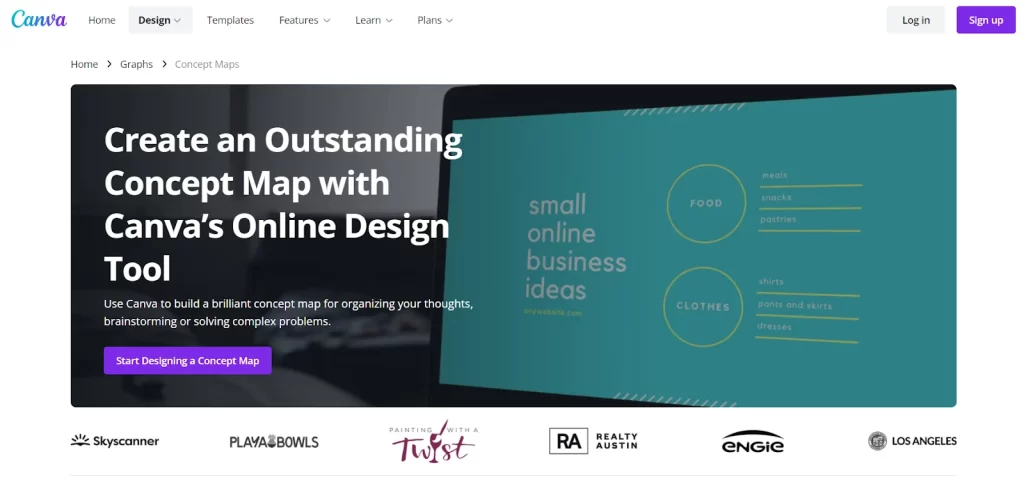
You can access all types of components from their library and connect them using various linkages. On the whole, Canva isn’t designed specifically for concept maps and it shows. While you can create one, it is certainly less intuitive than other tools on the list like Miro and Creately. However, where Canva does perform better is in providing other types of elements like emojis, pictures, audio, and moving graphics.
If you’re looking to create a ‘quick and dirty’ concept map specifically for arranging your thoughts, Canva may not be the best choice. In other words, Canva allows one to prepare directly for presentations.
Key Features
- Visual Board – Can be of any paper size, and is limited in size. Canva is a visual tool hence it offers many options for fonts, colors, backgrounds, etc.
- Templates – Canva’s templates are more aesthetic than functional. They do not follow the typical concept and linkage structure of concept maps. Instead, they are more similar to a final idea mapping template.
- Collaboration – Works similar to sharing and editing documents together on GSuite. One can share links with editing or viewing access.
Pricing
Free – Access to 2,50,000+ templates, and an entire editor with various fonts and post types. 5GB of cloud storage allotted with collaboration.
Pro plan at $12.99 per month – for up to 5 people, with 100 GB cloud storage and even greater access to stock graphics. It also allows access to tools like background remover, which however is not very useful for concept map making.
Enterprise plan at $30 per month – minimum 25 people, with unlimited storage.
Best Used For
Teams looking to create marketing graphics as well. To access Canva as a concept map maker, you will still need to get the entire design toolset. Hence, it makes sense to get it as an entire graphic tool and not just as a concept map maker online.
- Visme – For unique templates and interactive maps
Visme combines the best of Creately and Canva. As such, it is a tool that allows one to create concept maps on the go while ensuring it looks trendy, aesthetic, and postable. You can create concept maps following various branding colors, component styles, and linkage styles. Visme’s USP lies in its ability to offer interactive graphics. This is present in all their online tools from presentation makers to infographics.
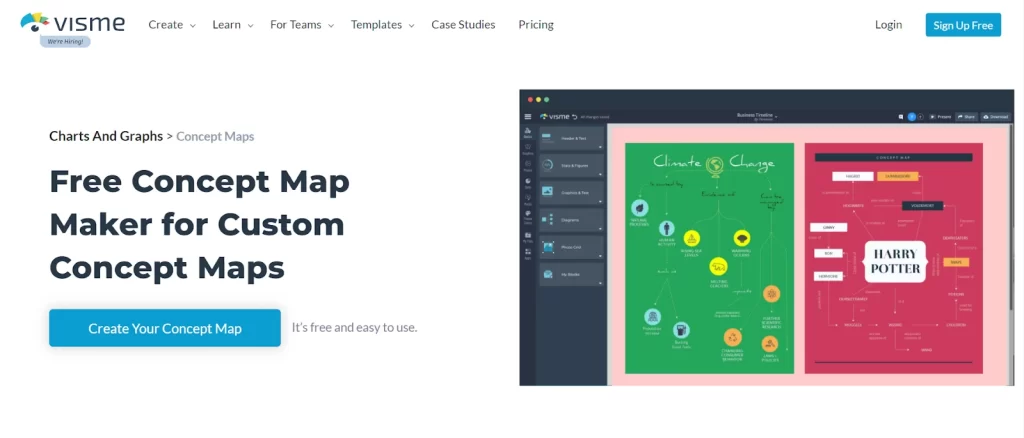
Their online concept map maker also includes this and one can easily add elements that bounce, fly or move on clicking. Similar to Creately and LucidChart, you can start making a concept map using available components and linking them using shortcuts. Later, you can add branding colors, graphics from their stock images library and add animations – similar to Canva! In terms of presentation, Visme stands ahead of Miro due to its offering of various fonts, element sizes, and colors. Visme supports both the quick creations of concept maps as well, polished final drafts.
You can also drag and drop your final product into any email, or get an embedded code that preserves all the animation you added!
Key Features
- Visual Board – a paper-based board of the set size. You can work with multiple boards side by side.
- Templates – Preset diagrams with auto-filled data for different types of concept map branches. Their lines snap onto one another so that even on moving, your linkages stay intact.
- Collaboration – Teams can work on it together, similar to working together on GSuite. Links for each map can be shared with limited editing access.
- Export – As all image types, PDFs, and direct saving to Dropbox or Drive. Online cloud storage is also assigned, even for free plan users.
Pricing
Free – Limited access to templates, 100 MB cloud storage. One does not have the ability to set their projects as private.
Personal plan at $15 per month – Full template access with 250 MB of online storage space, ability to download as PDF, and email support.
Business plan at $29 per month – All types of downloading options with 3GB online storage.
Enterprise plan – at custom pricing
Best Used For
Similar to Canva, Visme comes with an entire package with the presentation, infographic, social media post makers, and more. Hence, the high price tag on the product. It is best for designers and students looking to work on presentable graphics.
- Lucid Spark – A Miro update for designing and marketing teams
Online whiteboards have been all the rage for board meetings in 2021. Lucid Spark is such a whiteboard that allows one to document and structure their ideas. It has a special concept map maker that allows one to quickly write and link ideas. The infinite canvas and UI is very similar to Miro’s. All tools are present on the left and screen zooming is on the right. Lucid Spark also allows adding small comments anywhere on the screen, and following around the cursors of your team members.
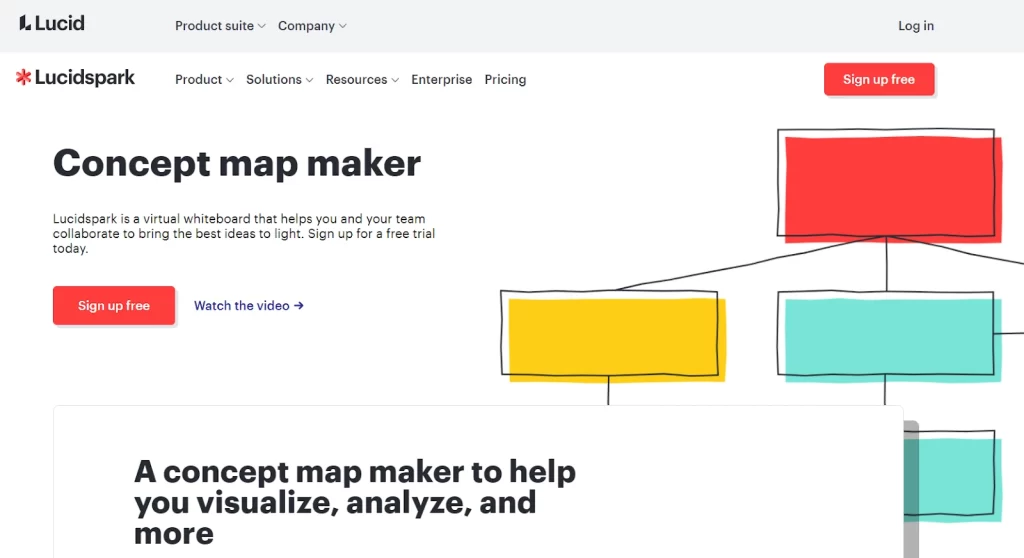
An interesting feature it includes is the “mention” feature. Here, you can tag a teammate in a comment using their name with an “@” symbol. Further, a separate note-taker exists as an overlying window, which is unique to Lucid Spark. The shape of each written concept is also not fixed. You can click on it and change its context – another feature not seen in most tools.
On the whole, Lucid Spark is an intuitive and quick concept map maker that certainly aids with creativity and visual thinking. It is a strong competitor for Miro with its similar but improved UI and near-similar prices.
Key Features
- Visual Board – Infinite canvas, with multiple element styles and libraries. Supports free-hand scribbles and drawings, can add links, video, and PDFs for references.
- Collaboration – Supports real-time collaboration. Conferences, chats, and shared notepads can follow cursors and add comments.
- Templates – for each mind map and concept map style including journey maps, timelines, schedules, etc.
- Export – supports all common export styles in image, PDF, and vector format.
- Admin Panel – for teams, to manage shared boards.
- Integrations – only with Slack, Drive, and Teams.
Pricing
Free – 3 editable boards with basic integrations and no access to admin controls or meeting tools like conferencing.
Individual plan at $7.95 per month – unlimited boards with above features, and added conference mode and voting feature
Team panel at $9 USD per month per user – requires a minimum of 3 users and allows full access to all features, but basic integrations only
Enterprise plan – custom pricing with access to all features and advanced integrations
Best Used For
Larger teams looking to manage multiple marketing, design, and strategizing teams. Lucid Spark offers resources for campus and corporate training which makes it ideal to get large-scale results.
- SmartDraw – Intelligent concept map maker for engineers
For a lot of free concept map maker tools, if you’ve seen one, you’ve seen them all. This type of standardization across products is great as people often change teams and companies. A minimal learning curve is ideal. SmartDraw is a concept map maker that excels at what it does due to its high automation! It is very smartly designed to allow you to draw complex concept maps with minimal clicks.
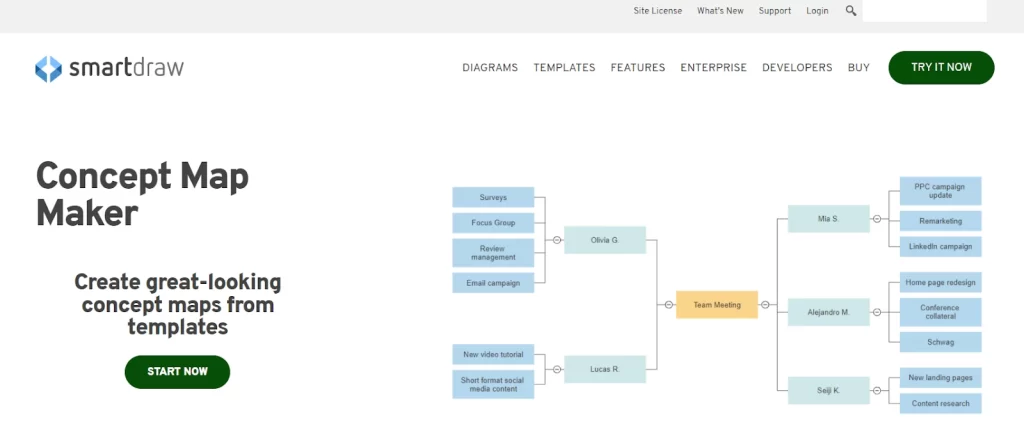
From auto arranging elements and linkages to offering presentation-ready themes with a single click, SmartDraw is truly a concept map maker worth investing in. One of SmartDraw’s features includes being able to convert your concept map into a Gantt chart – which can then be exported as a CSV file.
If you are working on a schedule, you can easily convert any “element” into a Trello card! This is of great help for taking notes in meetings and converting them into actionable work cards. SmartDraw’s intelligent formatting and integrating options set it apart from the rest. However, it is not a concept map maker for students or freelancers as they only cater on an enterprise basis.
Key Features
- Visual Board – Infinite canvas with multiple templates, presentation color modes, auto-formatting for linkages, and intelligent formatting for converting into Gantt charts and Trello boards. Can also be used for drawing accurate drawings similar to any CAD-like tool.
- Collaboration – Allows entire teams to work together and share work anywhere. Integrations and extensions can be customized.
- Export – Can directly export to Trello and Visio. Drawings and frames can be exported as images or PDFs.
Pricing
Enterprise pricing only
Best Used For
Large-scale professional teams – this includes designers and engineers. SmartDraw is a one-of-a-kind tool that offers a visual board that takes into account engineering powers. Hence, you can set drawing units and draw anything from a home plan to a circuit. It also offers developer tools for creating extensions.
- Zen Mind Map – Simple concept map maker for students and individual users
Are you easily distracted by popping notifications on your screen? Perhaps the availability of hundreds of templates confuses you rather than helps you? If so, then Zen Mind Map could aid your productivity with its clean-cut, noise-free UI. Zen Mind Map aims to provide a simple interface that mutes out on white noise.
You get an infinite canvas to work with, but no templates, and limited options with boxing styles. Essentially, Zen Mind Map is a stripped-down concept map maker that comes with one aesthetic style only. Instead, it focuses on allowing one to work on the content of a concept map – that is, creating topics and sub-topics.
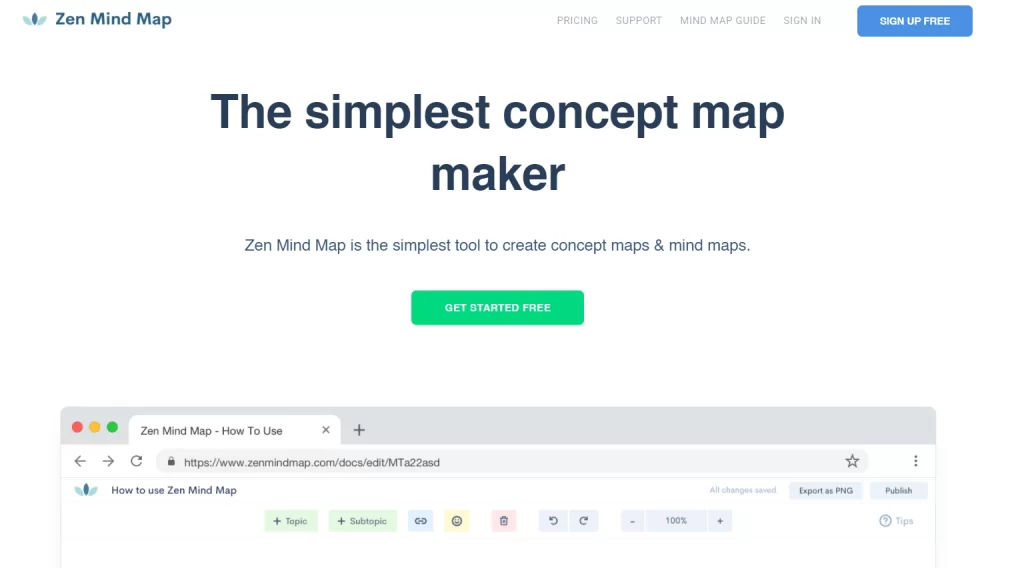
It is one of the coolest concept map makers for students or freelancers who are simply looking to organize their thoughts. Zen Mind Map also has various export and presentation options. While minimal, it does not have a non-presentable UI. Rather, it simply offers a singular style for all. The team also has other products for creating flowcharts and wireframes.
Key Features
- Visual Board – infinite canvas with no distractions, minimal options for customization, can add references as links only. Allows emoji addition.
- Export – Image export options available only. Can publish directly online.
Pricing
Free – Only 3 documents allowed, with limited nodes and sub-topics, can export as PNGs.
Pro plan at $4.9 per month – Priority support with access to updates and unlimited nodes and documents.
Best Used For
Students and freelancers. Zen Mind Map can be used by anyone looking to plan a strategy from novel writers to marketing teams. However, it does not offer collaboration features which makes it best for individual use.
- MindMup – Fully free online concept map maker
If you’re a cash-strapped student or simply looking to explore the world of concept maps before committing to the tool – let us introduce you to MindMup. MindMup is a fully free, online concept map maker. It works within your browser, however has all the features one usually finds in offline tools. Looking to save your work? MindMup allows one to save their files for up to 6 months onto the MindMup cloud assigned to each user! However, this cloud is public and one can pay for MindMup Gold to be able to save their files as private.
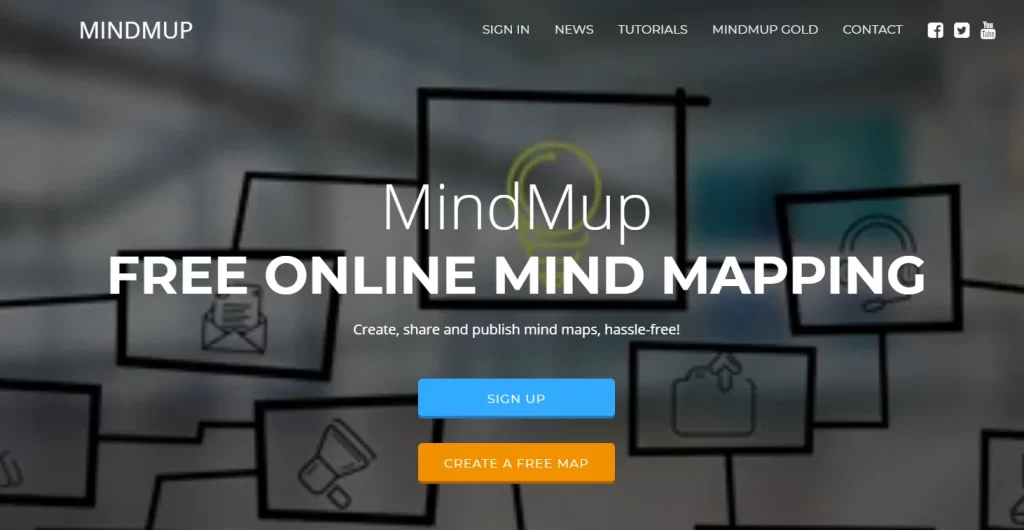
MindMup Gold also comes with some features like being able to view your history, saving files directly onto your Drive, and so on. On the whole, MindMup is a great tool to understand how concept maps work. The tool has many shortcuts that make creating a map fast and easy. However, the UI is quite dated when compared to its contemporaries. Its intelligent formatting abilities are also limited.
Key Features
- Visual Board – Infinite canvas, with options to change all visual styles like font size, color, sizes, and linkage designs. Can add links, images, and text notes to linkages.
- Templates – Basic themes and templates are available.
- Export – can be shared as images, PDFs, or documents.
- Collaboration – available for MindMup Gold only.
Pricing
Free – Access to all features, but limited space on MindMup Cloud, and cannot collaborate.
Personal Gold at $2.99 per month – Access to all features and Cloud, but cannot private maps.
Team Plan – variable pricing depending on the number of members. Access to all features except SSO login.
Organizational (domain) Gold at $100 per year – All features with robust cloud security measures and secure login.
Best Used For
Individual use. MindMup’s Gold features are quite cheap as compared to other tools, however, the UI could definitely use some updates.
- Venngage – Easy-to-understand concept map maker
Remember when we said Visme tried their best to bring both Creatly and Canva? Venngage does that, but better. Rather than providing a singular interface that caters to both rough scribbling and high-level presentations, Venngage separates the two and allows the user to decide what they want. You can either work on an infinite canvas, or choose a poster-size.
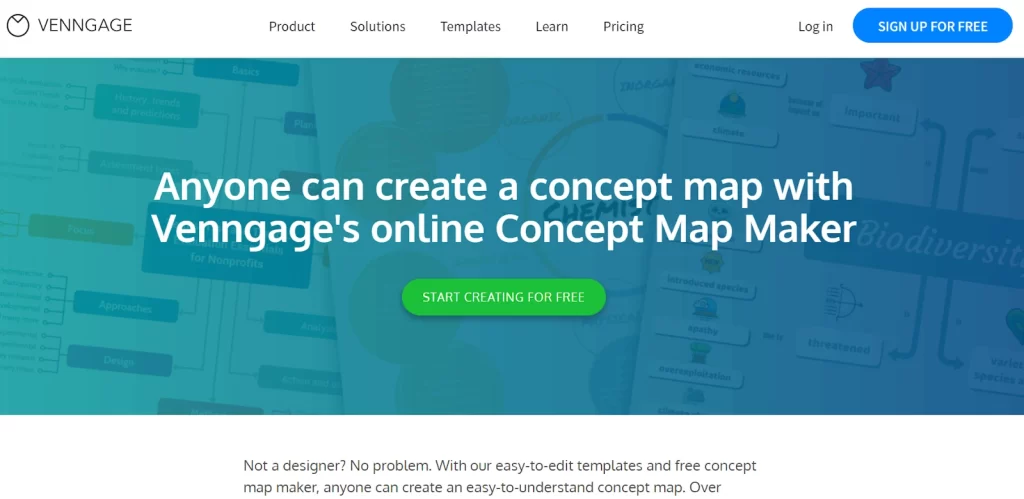
This freedom is great because it allows one to use Venngage purely as a concept map maker that has intelligent formatting, but also a presentation-based tool with amazing templates. The latter also includes a One-click Branding Kit that allows you to apply your brand colors and styles to every output.
Despite a Canva-like interface for presentations, Venngage makes it better by adding real-time collaboration where people can see each other’s actions and cursors. Of course, all of this comes with a higher price tag, but Venngage’s seamless UI makes it well worth the money.
Key Features
- Visual Board – Both infinite and limited options available, templates for timelines, infographics, mind maps, and more, various icons and stock images. Smart diagramming ensures that movement does not break up your design. My Brand Kit can save the logo, font styles, and logo branding.
- Templates – Access to widget styles, stock images, and premium icons.
- Collaboration – Can watch cursors across multiple boards.
- Export – apart from images and PDFs, Venngage can also save your files as interactive PDFs and PowerPoint presentations.
Pricing
Free – Can create up to 5 designs and upload 6 images
Premium plan at $16 per month – Unlimited designs and access to premium stock images – limited to 50 image uploads
Business plan at $39 per month – Collaboration with up to 10 members, My Brand Kit, and export options of PPT and HTML.
Enterprise plan at $499 per month – Onboarding and training sessions, custom tools like APIs, integrations, and custom MSLA.
Best Used For
Designers of all types! Whether you’re into user research or planning a new poster series, Venngage’s tools are full of great stock images, stickers, and PNGs that will give your output that extra jazz.
- Crello (VistaCreate) – Create concept maps in your brand style for free
Newly renamed as VistaCreate, Crello is an online design tool that can be used to create everything from Insta stories to recruitment posters. Among its various features is a concept map maker. VistaCreate’s concept map maker is an interactive creator that can add music, moving elements, premium widgets, and more. They also have a template gallery with 50+ templates and their stock of images, graphics, and icons.
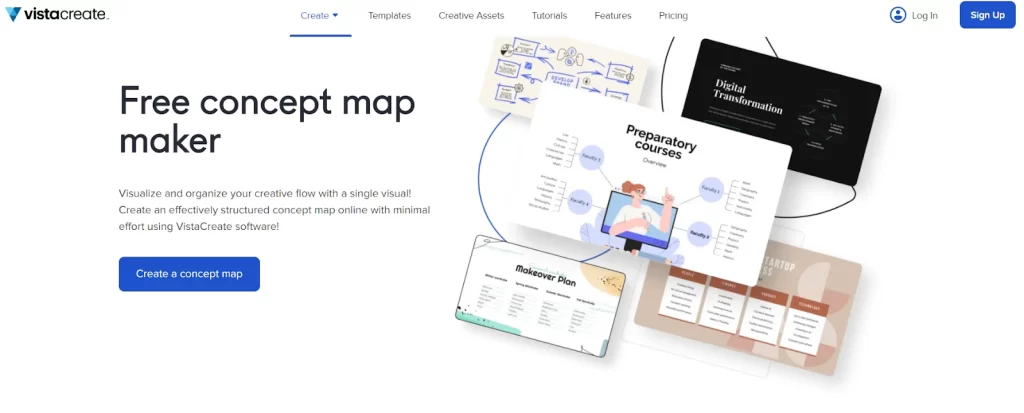
So, what’s special about VistaCreate? On the whole, VistaCreate is similar to Venngage, Canva, and Visme. It offers aesthetic map creation templates creatively crafted to stand out from the horde of boring maps in the market. VistaCreate is a visually focused tool It works well for final drafts but is not suited for rough scribbling.
Key Features
- Visual Board – Poster sizes ranging from blog covers to Linkedin posts. Templates are divided based on industry, occasion type, and platform. MyBrand Kit allows the saving of brand colors, fonts, and logos. Cloud storage available. The stock library contains images, music, videos, and icons.
- Collaboration – Up to 10 members can collaborate in real-time.
- Exports – All common export modes are available.
Pricing
Free – 10 GB of storage, with My Brand Kit, access to a stock library, and creative assets.
Pro plan at $10 per month – Unlimited access to Brand Kit, stock library, and ability to create a team account.
Best Used For
Designers and marketing experts will find it to be of great use. The templates are post-worthy and can be directly shared on social media platforms. In fact, VistaCreate also has poster ratio templates for various platforms – like Facebook covers, Instagram posts, and so on.
VistaCreate comes with a whole package that includes video editing – hence, it works well for social media teams. Moreover, VistaCreate has both an iOS and Android phone application! Moreover, their free plan comes with the My Brand Kit which is usually a paid option in other tools.
- From Wondershare
One of the top software solutions in the world, Wondershare has everything from film editing tools to file recovery kits. Be it related to organizing your digital desk, or creating infographics – Wondershare has it! So, here’s we’re looking at 3 concept map makers from Wondershare that allow one to create concept maps of varying complexity.
- EDrawMind – Get concept maps from Word docs in seconds
Earlier named MindMaster, EDrawMind is a visual mapping tool that comes as an offline software. Among the 3 tools by Wondershare, EDrawMind is the one that offers simplicity and cleanliness. In fact, the UI is very similar to Zen Mind Map. While it has many templates, ranging from circular to rectangular mind map boxes – all of them work with intelligent formatting.
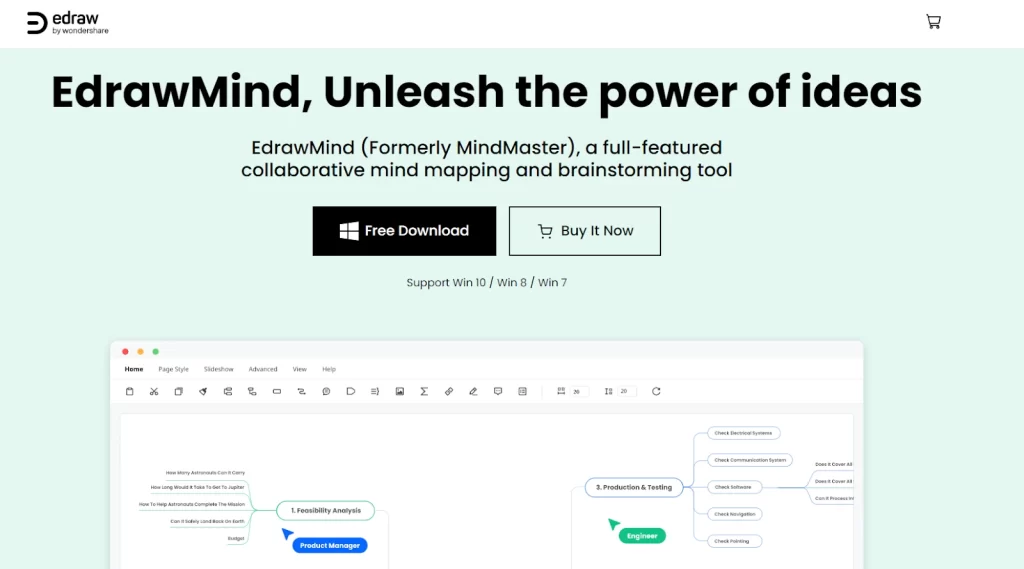
EDrawMind also includes a separate panel that lists down all your ideas so that you can refer to them at a glance. The advanced section allows conversion into Gantt charts, whereas you can export your file as anything from images to PPT. However, EDrawMind excels in its automation – where it can select keywords and transform any Word, HTML, or Markdown into a concept map all by itself!
Key Features
- Visual Board – infinite canvas with various templates, box styles, linkage styles, and options to change the font, color, and box size. Themes can be saved to include a branding kit. Can generate a concept map from a document and includes smart editing that preserves linkages.
- Collaboration – Allows multiple team members and shows real-time cursors.
- Templates – Different styles and types of concept maps.
- Export – as images, PDF, PPT, Word, and Excel. Can transfer to and fro from Dropbox.
Pricing
Subscription plan at $59 per year – 1GB cloud storage with all-device accessibility.
Lifetime plan for $145 – Full access with 10 GB storage space and file recovery.
Lifetime bundle plan at $312 – Access to concept map maker, visual diagramming tool, and design tool.
Best Used For
Saving time, energy and encrypted with SSL, EDrawMind is great for enterprises looking to work remotely. Since it is an offline tool – it is not limited to the drive space allotted to your browser. Thus unlike tools like Miro and Creately, it is not slowed down by many members working on it at once.
- EDrawSoft – Offline concept map tool for enterprises
If you’re looking for a wider template range and a presentation-level concept map maker, then EDrawSoft is a step up from the earlier tool. Available as an offline tool, EDrawSoft divides concept maps by their industry. You can get templates for teaching lessons in Biology, design maps for customer journeys or strategy maps for your marketing funnel program,
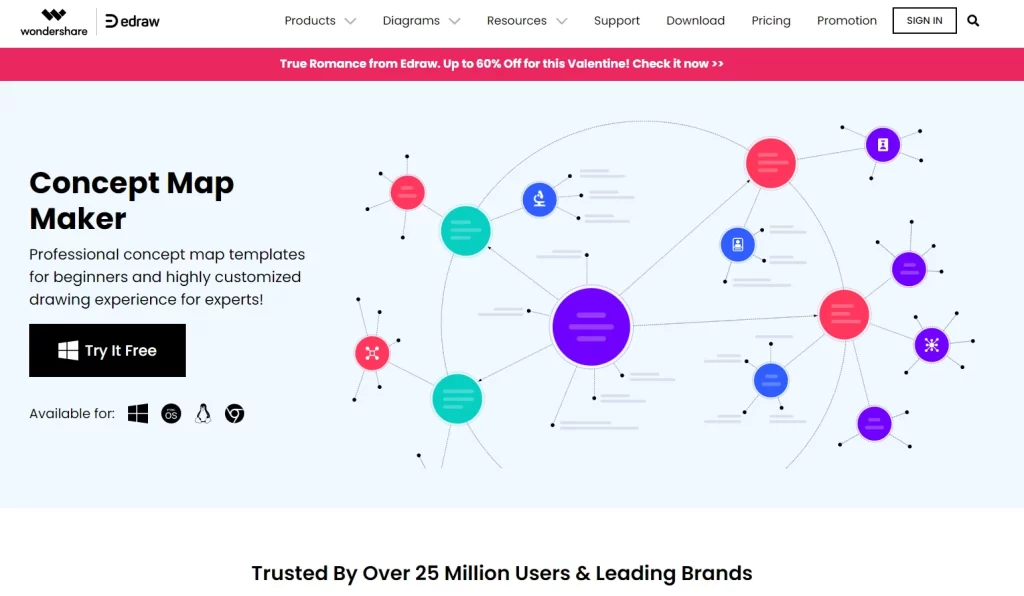
Apart from concept maps, EDrawSoft can also be used for bubble diagrams, mind maps, flowcharts, and other types of organizational visuals. EDrawSoft’s USP resides in its multi-platform compatibility that allows easy exporting, sharing, and collaboration with teammates. If you’re looking for a one-time pay tool for your team – EDrawSoft is well worth investing in.
Key Features
- Visual Board – infinite canvas with various diagram types and linkage styles. All can be edited on the basis of font, color, and size. Themes can be set and changed. Can add images, and links as references.
- Collaboration – real-time cursor viewing, can assign team members to different boards and devices.
- Templates – 250+ diagram templates and divisions by industry styles.
- Export – as images, PDF, PPT, and Word files. Can draw canvases and export them together.
Pricing
Lifetime bundle at $245 – includes full access to all features.
Lifetime plan for $312 – includes EDrawMax, EDrawInfo, and EDrawMind.
Lifetime plan for $145 – includes EdrawMind – a visual diagramming tool
Best Used For
- EDrawMAX – Get both online and offline tool for concept map making
Advertised as a visual map maker, EDrawMAX is available for both offline and online use as EDrawMAX Online. For beginners, EDrawMAX is a boon. The interface is similar to MS Word and is extremely visual. Everything is present on the screen – the learning curve is minimal. Existing templates come pre-filled. Linkages use intelligent formatting and there is a free trial version for you to get accustomed to it!
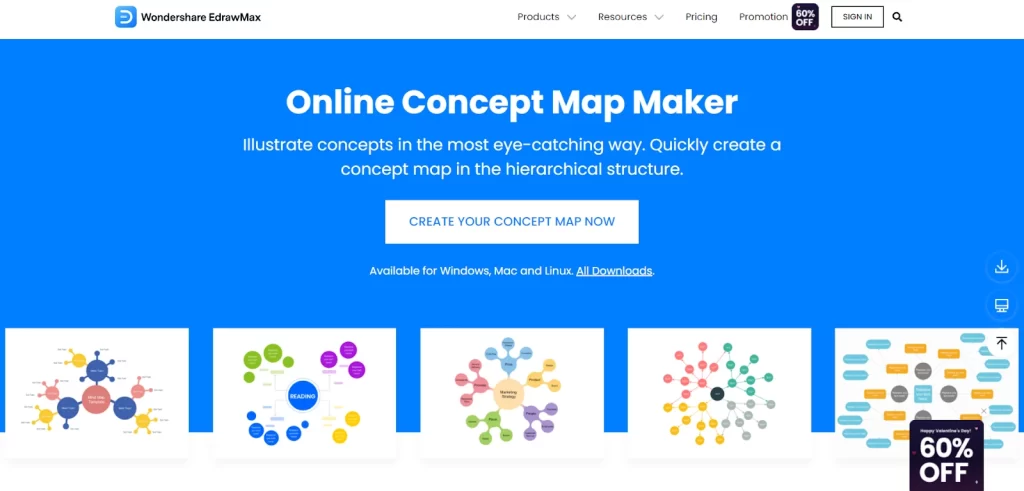
EDrawMAX is mainly aimed at designers, educators, and engineers. Whether you’re looking to streamline your software or create a visual map for your new app – EDrawMAX can cater to them all. EDrawMAX also uses small shortcuts and gestures to make map-making an intuitive activity.
Key Features
- Visual Board – hundreds of existing templates, infinite canvas. Can add images, and links. Smart formatting and hierarchical mapping.
- Collaboration – real-time collaboration allowed and showed.
- Export – can export as images, PDF, PPT, and Word files.
Pricing
Subscription plan at $99 per year – 1GB cloud storage and full access to the entire platform.
Lifetime plan at $245 – 10 GB cloud storage and access to the full platform and file recovery tools.
Lifetime bundle plan at $312 – Access to concept map maker, visual diagramming tool, and design tool.
Best Used For
As a cross-platform tool, EDrawMAX works best for companies that are used to using various EDraw diagramming tools.
FAQs on Concept Map Maker
- How do I use a concept map maker?
A concept map maker will allow you to create topics, and keep adding sub-topics to it. If you are beginning from scratch, write down the central theme or topic. And then keep adding hierarchical subdivisions to it. These divisions can be connected to it by any type of categorization.
Add the division type to the linkage, and if needed add a reference image, video, or PDF for the same. You can give different colors and shapes to the elements of the topics and sub-topics to distinguish them visibly. Once done, you can export it in the form of an image or document.
- What are some existing examples of concept maps?
Depending on the type of branching and topic, concept maps can be of many types. Concept map makers have templates for each kind. Here’s an example of a radial concept map used by marketing teams.
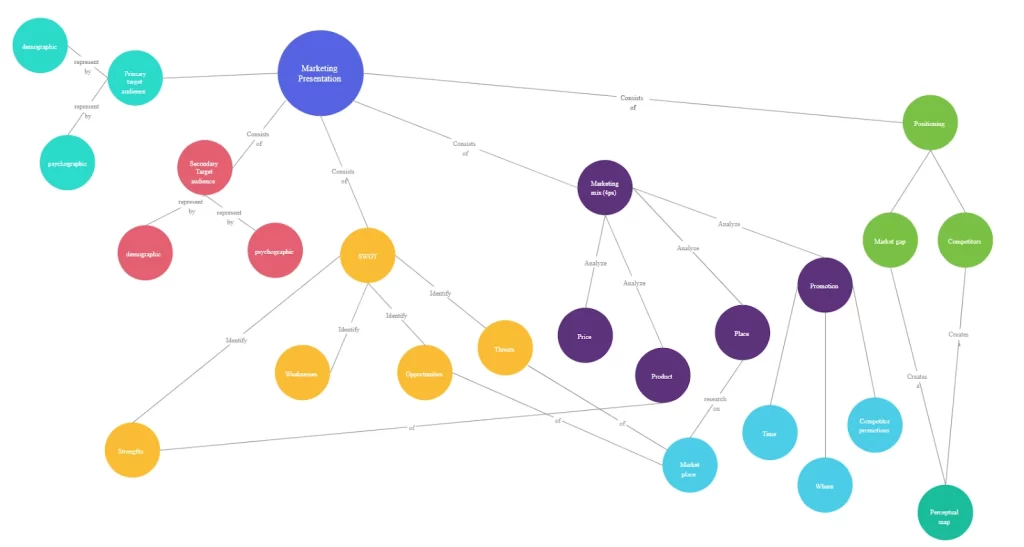
Source: Creately
If you are an educator, you may prefer a more structured concept map explaining how various concepts are connected. Here’s a concept map template explaining cellular respiration. Images are included as references.
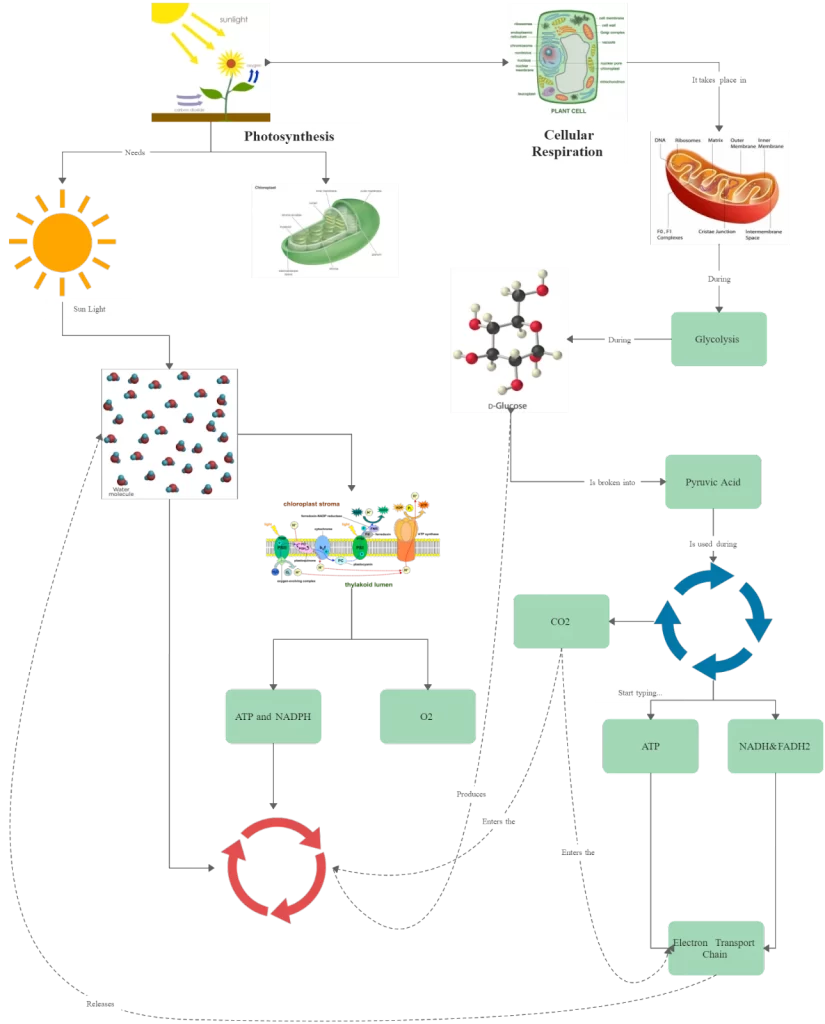
Source: Biology Corner
Alternatively, here’s a branching concept map used by sales teams.
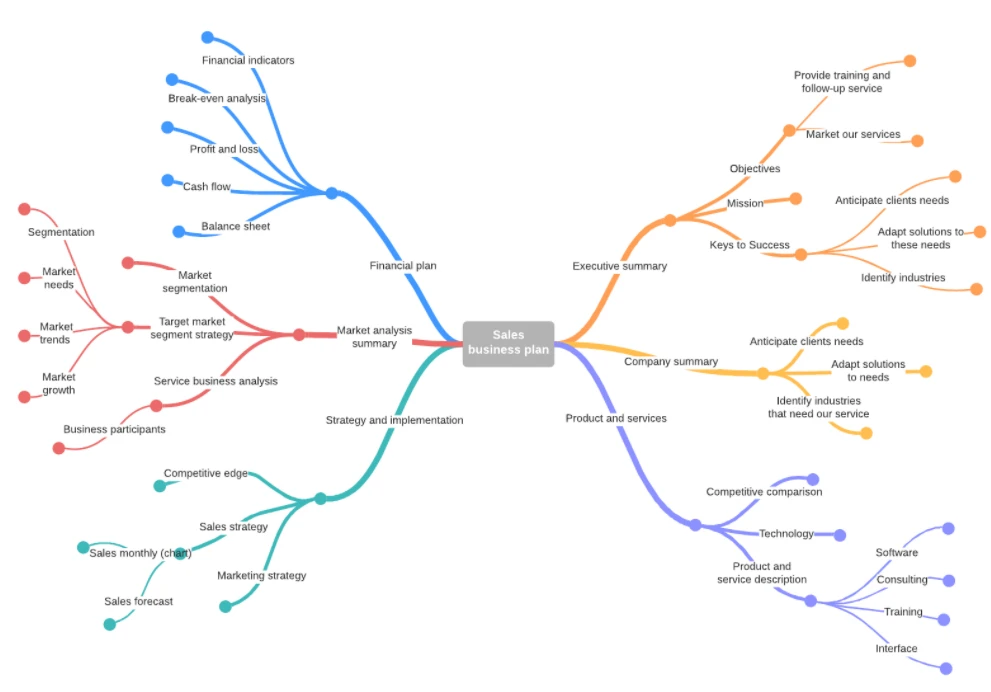
Source: Visme
You can also opt for concept maps that are more aesthetic and poster-like in nature like these:
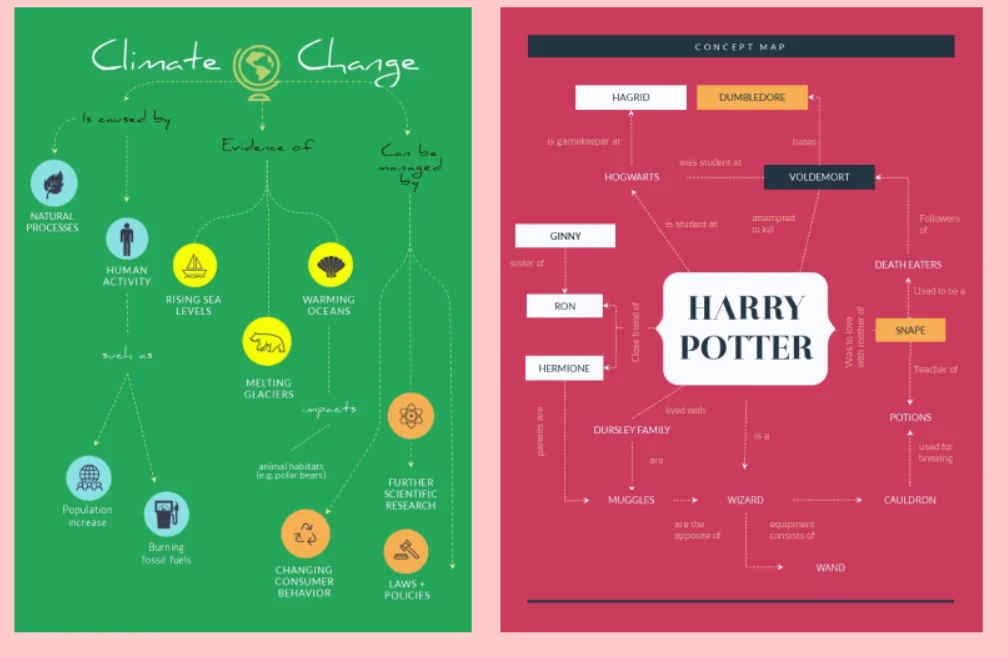
Source: Visme
- Can a concept map be animated?
This depends on the concept map maker you use. Some tools like Visme support interactive concept maps with gifs and elements that move when clicked.
- What if I need to restructure my concept map?
Once you add linkages between different elements in a concept map maker, they get linked and will retain this property irrespective of how you move the elements. This is an example of smart formatting. Tools like Miro also have options where a disorderly concept map is structured into a square grid with one click.
- Which is the best, free concept map maker for students?
Students can get the free version of MindMUP, Miro, or Canva. Brands on the other hand should opt for tools that offer My Brand Kits for easier brand alignment. This includes tools like Venngage, VistaCreate, and all 3 tools from Wondershare.
Wrapping up,
That concludes our list of concept map makers! While most offer free plans that you can test out – Miro, Canva, Creately remain fan favorites that are widely used by millions.
Depending on the features and tools your team needs, you can opt for any of the above-discussed concept map makers. If you’re looking for a concept map maker for students, choose tools like Miro or Zen Mind Map that offer good free plans and allow collaboration. Graphic and marketing teams can opt for Canva, Visme, Venngage, or Creately. Designers and engineers can go for EDrawMax, MindMUP, or Crello.
If you’re new to the world of concept maps and simply want to explore, use MindMUP to quickly access an online concept map maker without logging in or paying. We hope this article helps you restructure your ideas and find breakthroughs!